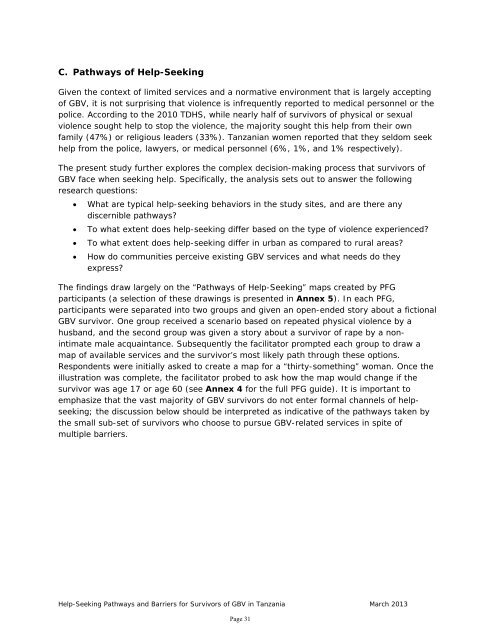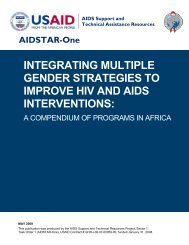Download PDF - ICRW
Download PDF - ICRW
Download PDF - ICRW
You also want an ePaper? Increase the reach of your titles
YUMPU automatically turns print PDFs into web optimized ePapers that Google loves.
C. Pathways of Help-Seeking<br />
Given the context of limited services and a normative environment that is largely accepting<br />
of GBV, it is not surprising that violence is infrequently reported to medical personnel or the<br />
police. According to the 2010 TDHS, while nearly half of survivors of physical or sexual<br />
violence sought help to stop the violence, the majority sought this help from their own<br />
family (47%) or religious leaders (33%). Tanzanian women reported that they seldom seek<br />
help from the police, lawyers, or medical personnel (6%, 1%, and 1% respectively).<br />
The present study further explores the complex decision-making process that survivors of<br />
GBV face when seeking help. Specifically, the analysis sets out to answer the following<br />
research questions:<br />
<br />
<br />
<br />
<br />
What are typical help-seeking behaviors in the study sites, and are there any<br />
discernible pathways?<br />
To what extent does help-seeking differ based on the type of violence experienced?<br />
To what extent does help-seeking differ in urban as compared to rural areas?<br />
How do communities perceive existing GBV services and what needs do they<br />
express?<br />
The findings draw largely on the “Pathways of Help-Seeking” maps created by PFG<br />
participants (a selection of these drawings is presented in Annex 5). In each PFG,<br />
participants were separated into two groups and given an open-ended story about a fictional<br />
GBV survivor. One group received a scenario based on repeated physical violence by a<br />
husband, and the second group was given a story about a survivor of rape by a nonintimate<br />
male acquaintance. Subsequently the facilitator prompted each group to draw a<br />
map of available services and the survivor’s most likely path through these options.<br />
Respondents were initially asked to create a map for a “thirty-something” woman. Once the<br />
illustration was complete, the facilitator probed to ask how the map would change if the<br />
survivor was age 17 or age 60 (see Annex 4 for the full PFG guide). It is important to<br />
emphasize that the vast majority of GBV survivors do not enter formal channels of helpseeking;<br />
the discussion below should be interpreted as indicative of the pathways taken by<br />
the small sub-set of survivors who choose to pursue GBV-related services in spite of<br />
multiple barriers.<br />
Help-Seeking Pathways and Barriers for Survivors of GBV in Tanzania March 2013<br />
Page 31

















